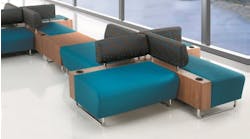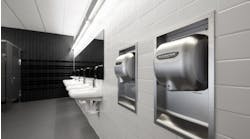Federal, state and local initiatives are promoting sustainable building design and construction as a means to preserve natural resources and enhance building performance.
Sustainable building design benefits the bottom line in three key areas. Economic benefits include reduced life-cycle and operating costs. Environmental pluses include increased energy and water efficiency, reduced pollution and reduced landfill waste. Society benefits through decreased impact on the environment and increased comfort, health and quality of life for building users.
An integrated approach
To develop a sustainable facility successfully, a school must bring together the right stakeholders: school administrators, architects, engineers, constructors, building users and facility operators. They help establish clear goals for the building program, budget, schedule, aesthetics, environmental impact, and operations and maintenance at the conceptual design phase.
An integrated design approach provides greater opportunities for constructability reviews and “true” value engineering to improve the budget and schedule. It also affords members of the project team earlier opportunities to identify and seek financial incentives that may reduce capital costs or operating expenses.
Early participation of key members of the project team is important for any building project, but it is essential for a sustainable facility. Designing a sustainable building is more rigorous and time-intensive than a typical design. Yet, over the life of a building, this investment will generate higher performance at reduced operating costs.
A rigorous commissioning/quality-control process is another key element of an integrated design approach. Commissioning ensures that what has been designed and constructed meets the criteria of both the school and the architect. The process includes testing equipment and systems, and, if necessary, design reviews by a third party.
A systematic process
Creating a sustainable building requires far more than putting solar panels on the roof. Sustainable design follows a systematic process:
- Minimize demands
First, consider how the energy, water and material the facility requires can be reduced. This analysis looks at the siting of the building in the landscape, the relationship of building volume to surface area, the design and components of the building envelope, energy-efficient lighting strategies, the use of recycled water systems, and the effects of each strategy on energy and water requirements and on interactions among building systems.
- Use passive systems
Examine how to incorporate other passive technologies as a means of conditioning a building, including daylighting, natural ventilation, mechanical ventilation without refrigeration, evaporative cooling and passive solar heating.
- Optimize active systems
Because passive systems will not provide all the energy a building needs to function, look at strategies to optimize the mechanical, electrical and plumbing systems. This includes a high-efficiency mechanical system and controls; high-efficiency lighting fixtures, lamps and controls; and high-efficiency plumbing fixtures.
Having minimized demands and incorporated passive systems, it is possible to make the active systems smaller than what would be required in a conventional building. This will reduce capital costs and improve the building's operational efficiency.
- Consider environmentally benign power alternatives
At this point, on-site renewable energy sources can be considered. Photovoltaic panels are the most feasible renewable power alternative for school buildings because they can be mounted easily on a roof, or integrated into the building envelope. Other alternatives — fuel cells and micro-turbines — generate electricity and hot water on site. They produce little pollution, but rely on natural gas as a fuel source, so they cannot truly be considered renewable power.
- Mitigate waste
Additional ways to mitigate waste include using local, salvaged and recycled materials, as well as environmentally benign and non-toxic materials.
Objective ratings
The Leadership in Energy and Environmental Design (LEED) Green Building Rating System is an excellent tool to focus the design process. Developed by the U.S. Green Building Council (USGBC), the LEED system is a voluntary, consensus-based national standard for developing high-performance, sustainable buildings.
The rating system awards a total of 69 points in five categories:
- Sustainable Site Development
This includes strategies to address development, footprint and open space, parking, access to public transportation, storm-water management and landscaping.
- Water Efficiency
This includes the effects of landscape irrigation and use of potable water for sewage conveyance; and using grey- or black-water systems and constructed wetlands.
- Energy Efficiency and Atmospheric Emissions
This includes system efficiency, renewable energy and HVAC refrigerant type.
- Materials and Resources for Construction
This includes building renovation and adaptive reuse; use of local, recycled and salvaged materials; and use of certified wood and rapidly renewable materials such as bamboo.
- Indoor Environmental Quality
This includes volatile organic compound emissions, access to daylighting and views to outside, indoor air quality and local environmental control.
Based on the total number of points, the building receives one of four classifications (in ascending order): certified, silver, gold or platinum.
A project can be registered with USGBC at any time, but certification is not awarded until construction is completed, or, in some cases, until certain processes, such as a “building flush-out,” are completed. Registering buildings at the schematic design stage is helpful because the USGBC will provide design assistance and feedback.
Bolin, P.E., is vice president for sustainable design in the Los Angeles office of Syska Hennessy Group, a consulting, engineering, technology and construction firm.
NOTABLE
The Leadership in Energy and Environmental Design (LEED) Green Building Rating System awards a total of 69 points in five categories:
-
SUSTAINABLE SITE DEVELOPMENT
-
WATER EFFICIENCY
-
ENERGY EFFICIENCY AND ATMOSPHERIC EMISSIONS
-
MATERIALS AND RESOURCES FOR CONSTRUCTION
-
INDOOR ENVIRONMENTAL QUALITY
SIDEBAR: Sustainability at Los Angeles City College
The $15 million Student Admissions Building and Parking Garage at Los Angeles City College is part of Los Angeles Community College District's $1.245 billion Proposition A Bond Program. The project, the first major new construction on the campus in nearly 20 years, has been designed to LEED standards.
The 28,000-square-foot student admissions building will consolidate many student services into one facility, including admissions, orientation, counseling, registration and financial aid. The 570-car above-ground parking garage will provide added parking capacity, and will allow future Proposition A projects to be built on existing surface parking lots elsewhere on campus.
The single-level narrow-plan building will provide daylighting throughout the facility. The parking garage concrete will include as much recycled content aggregate and fly ash as possible without compromising structural integrity. Under-floor air distribution is provided throughout the facility to promote energy efficiency, indoor air quality, and flexibility in space planning and information technology. Low-emitting finishes and materials, demand-controlled ventilation and high-efficiency air filtration will help maintain good air quality in the facility.
The high-efficiency lighting averages about 0.8 watts per square feet of interior lighting power. Automatic daylight dimming controls will reduce lighting power consumption in open areas. Automated window shades will provide glare control for east-facing glazing. Anticipated energy consumption for the facility is 25 percent below California's Title 24 standards.
A 75-kilowatt rooftop grid-connected photovoltaic system will supply more than 30 percent of the anticipated total energy consumption for the facility. Incentives from the Los Angeles Department of Water and Power will pay for nearly half the $900,000 cost of the large rooftop photovoltaic system. The Southern California Gas Company also is providing an incentive of about $25,000.
LEED Silver certification is anticipated upon completion of the building, which is scheduled for completion in September 2004.

